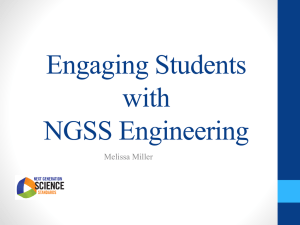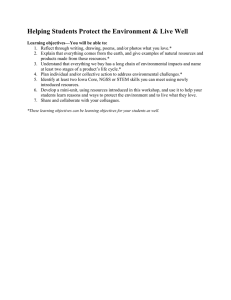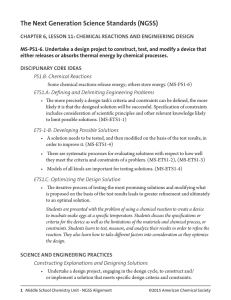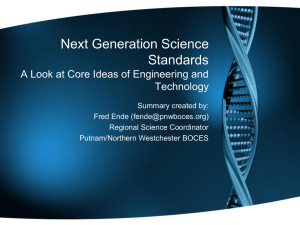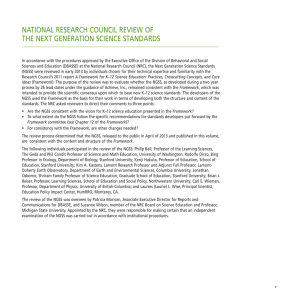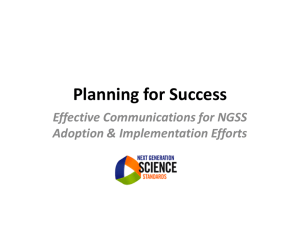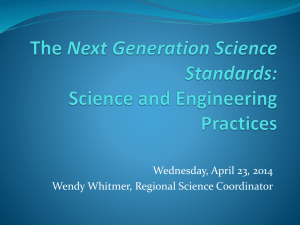Adapt Discard? or
advertisement
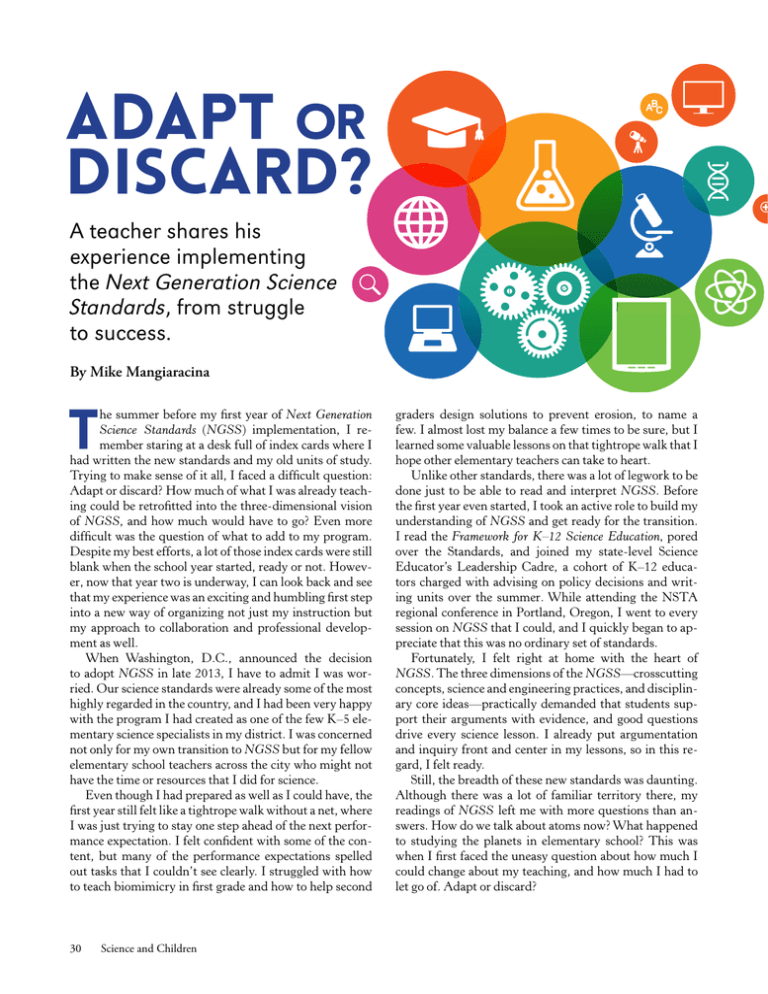
Adapt or Discard? A teacher shares his experience implementing the Next Generation Science Standards, from struggle to success. By Mike Mangiaracina T he summer before my first year of Next Generation Science Standards (NGSS) implementation, I remember staring at a desk full of index cards where I had written the new standards and my old units of study. Trying to make sense of it all, I faced a difficult question: Adapt or discard? How much of what I was already teaching could be retrofitted into the three-dimensional vision of NGSS, and how much would have to go? Even more difficult was the question of what to add to my program. Despite my best efforts, a lot of those index cards were still blank when the school year started, ready or not. However, now that year two is underway, I can look back and see that my experience was an exciting and humbling first step into a new way of organizing not just my instruction but my approach to collaboration and professional development as well. When Washington, D.C., announced the decision to adopt NGSS in late 2013, I have to admit I was worried. Our science standards were already some of the most highly regarded in the country, and I had been very happy with the program I had created as one of the few K–5 elementary science specialists in my district. I was concerned not only for my own transition to NGSS but for my fellow elementary school teachers across the city who might not have the time or resources that I did for science. Even though I had prepared as well as I could have, the first year still felt like a tightrope walk without a net, where I was just trying to stay one step ahead of the next performance expectation. I felt confident with some of the content, but many of the performance expectations spelled out tasks that I couldn’t see clearly. I struggled with how to teach biomimicry in first grade and how to help second 30 Science and Children graders design solutions to prevent erosion, to name a few. I almost lost my balance a few times to be sure, but I learned some valuable lessons on that tightrope walk that I hope other elementary teachers can take to heart. Unlike other standards, there was a lot of legwork to be done just to be able to read and interpret NGSS. Before the first year even started, I took an active role to build my understanding of NGSS and get ready for the transition. I read the Framework for K–12 Science Education, pored over the Standards, and joined my state-level Science Educator’s Leadership Cadre, a cohort of K–12 educators charged with advising on policy decisions and writing units over the summer. While attending the NSTA regional conference in Portland, Oregon, I went to every session on NGSS that I could, and I quickly began to appreciate that this was no ordinary set of standards. Fortunately, I felt right at home with the heart of NGSS. The three dimensions of the NGSS—crosscutting concepts, science and engineering practices, and disciplinary core ideas—practically demanded that students support their arguments with evidence, and good questions drive every science lesson. I already put argumentation and inquiry front and center in my lessons, so in this regard, I felt ready. Still, the breadth of these new standards was daunting. Although there was a lot of familiar territory there, my readings of NGSS left me with more questions than answers. How do we talk about atoms now? What happened to studying the planets in elementary school? This was when I first faced the uneasy question about how much I could change about my teaching, and how much I had to let go of. Adapt or discard? December 2015 31 PHOTO COURTESY OF THE AUTHOR A few practices I needed to change were clear. I used to teach whole units on what were once called the “process standards,” where students’ observations of mealworms, for example, came in the context of lessons on journaling and communication skills. I also took annual breaks from my science teaching for the muchloved engineering challenges that I led across grade levels, sometimes even extending to faculty, parents, and the administration. All this would have to change now, as NGSS’s hallmark was that engineering challenges and process skill-building happen all the time, embedded with the content. I was worried too about having to let go of some of my favorite topics. How would I teach about Silly Putty can help bundle concepts. potential and kinetic energy in third grade now? What about the fourth-grade plant extheir discoveries, I began a practice of carrying a little noteperiments and our adoption of the local watershed? Adapt book in class and jotting down all I could of what students or discard? were saying. Keeping my focus on argumentation, I was Gradually, I found a way for some of my favorite units able to use these notes to reflect, week after week, on the to make the cut. My third graders, for example, built cars questions and explanations that students presented. My that could be powered by magnets or balloons, bringing second graders, for example, struggled with the question together performance expectations in magnetism and balof whether silly putty was a solid or a liquid. We would anced and unbalanced forces that replaced the old energy begin each class with a reading of their quotes from past standards. My fifth graders began their year discovering conversations, reconciling statements like, “When you that Elodea plants placed under lights will produce oxygen leave it for a long time, it takes the shape of its container,” bubbles, while those out of the light do not. This discovery with “When you hit it with a hammer it bounces.” made photosynthesis the basis of both the fifth graders’ By keeping the conversations centered on students’ ecology studies and their unit on chemical changes. own words, I saw that they were better able to marshal eviThese successful lessons gave me one important key for dence to support what they had said, or see that evidence cracking the NGSS. With such a wide range of standards was lacking and let go of old theories. When conversations to teach and so few minutes left for science in the weekly really began to thrive, I knew that my students were havschedule, the only hope for good implementation would ing a good year, and I could rest a little easier. be for concepts and standards to be bundled and become There were still growing pains, and the successful lesmore than the sum of their parts. Students needed to make sons sometimes seemed like the exceptions. At times I felt discoveries that provided a lot of bang for the buck and like I was faking it, holding on to a lot of my old lessons for supported multiple units of study. I looked for more unithe wrong reasons. In the heat of planning, I sometimes fying phenomena like the Elodea plants. gave up on forging a new path and fell back on old lessons Once I started planning with these unifying discoveries that were not aligned, or that barely connected to NGSS. in mind, things began to flow. My second graders studMidway through the year, I knew I had reached the ied and then made their own silly putty to bring together limit of what I could do by myself, and I began to seek concepts in solids and liquids and testing materials. My other science teachers who were sharing my struggle. Soon fourth graders built telegraphs to both construct a device a group of us from schools across the city began meeting that converted between forms of energy and used signals regularly. Our time together was marked as much by comto communicate. miseration as it was by sharing best practices. Talking with To help students reflect on the connections between these new colleagues, I saw that everyone was doing their Adapt or Discard? best, but we were all feeling torn between our old lessons and the new vision. My challenges were far from over, but together we were able to go a little easier on ourselves for not having the brilliant first year we would have wanted. This would clearly be a multiyear transition. Gradually, we began to share some lessons that were working. My magnetic cars and Elodea plants joined a pool of other teachers’ lessons that included innovative work with mirrors and light in fourth grade and designing sunshades in first grade. We finished the school year with a summer meeting where, over Chinese food on a back porch, we took turns sharing our favorite lessons at all grade levels, leaving us with a master list to frame our summer planning and get year two off on the right foot. Now that the second year is underway, my attitude is worlds apart from where it was this time last year. Instead of a pile of blank note cards, I now have a small collection of my and others’ successful lessons that I can start fitting together. I still have holes in my long-term plans, and there is much work to do in bringing the disparate threads of these three-dimensional standards together, but a big- ger picture is beginning to take shape. I can rest easier knowing that I’ve gotten through one year of this and that the upcoming year will be even more successful. I’m not alone, and the learning that lies ahead for my students, my fellow teachers, and me is looking bright. ■ Mike Mangiaracina (mike.mangiaracina@gmail.com) is a K–5 science specialist in Washington, D.C. Acknowledgment Thank you to Alisa Glassman, who made it possible for me to write this. Thank you to Natalie Harr Ylizarde for her many helpful suggestions and support. References National Research Council (NRC). 2012. A framework for K–12 science education: Practices, crosscutting concepts, and core ideas. Washington, DC: National Academies Press. NGSS Lead States. 2013. Next Generation Science Standards: For states, by states. Washington, DC: National Academies Press. www.nextgenscience.org/next-generation-science-standards. With properties of a solid and a liquid, Silly Putty is sure to promote authentic questioning. 32 Science and Children
